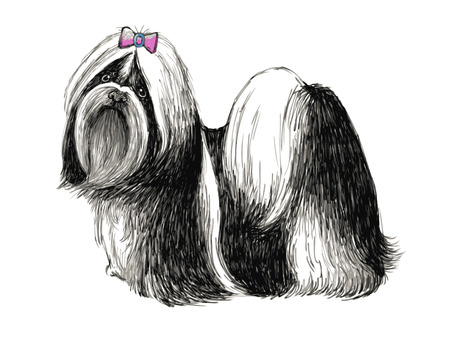Introduction
Dog grooming is more than just a cosmetic routine—it’s an essential aspect of responsible pet ownership in American households. Whether you have a fluffy Golden Retriever or a sleek Boston Terrier, regular grooming helps maintain your dog’s health, comfort, and happiness. Grooming routines typically include bathing, brushing, nail trimming, ear cleaning, and sometimes even dental care. In the United States, where dogs are often treated as beloved family members, keeping them clean and well-groomed isn’t just about looking good for the neighbors; it’s about preventing skin issues, controlling shedding, and strengthening the bond between pets and their owners. This article explores the differences between professional dog grooming services and at-home DIY grooming, providing insight into the pros, cons, and costs of each option so you can make the best choice for your canine companion.
2. What Professional Dog Grooming Involves
When you book an appointment with a professional dog groomer, youre not just getting a quick bath and brush. Instead, professional grooming is a comprehensive service that’s tailored to your pet’s breed, coat type, health needs, and temperament. Here’s what you can expect during a typical visit:
Core Services Offered by Professional Groomers
| Service | Description | Frequency Recommended |
|---|---|---|
| Bathing & Drying | Deep cleansing with breed-appropriate shampoos, followed by gentle drying techniques. | Every 4-6 weeks |
| Haircut/Trimming | Clipper or scissor cuts based on breed standards or owner preference. | Every 4-8 weeks (varies by breed) |
| Nail Clipping & Filing | Nails trimmed to a safe length and filed smooth to avoid snags or injuries. | Every 3-4 weeks |
| Ear Cleaning & Plucking | Ears checked for wax, debris, or infection; hair plucked if necessary to improve airflow. | As needed (often every visit) |
| Anal Gland Expression | Glands expressed externally if needed for comfort and hygiene. | As needed (varies by dog) |
| Brushing & De-shedding | Removal of loose fur and undercoat using specialized tools. | Every visit; more often for double-coated breeds |
The Grooming Experience: What Pet Parents Can Expect
- Personal Consultation: Groomers discuss your dog’s unique needs—age, health conditions, behavioral quirks, and styling preferences—before starting any work.
- Spa-Like Environment: Many salons offer calming settings with aromatherapy, soft music, or special waiting areas to minimize stress for both pets and their humans.
- Safety Protocols: Reputable groomers use sanitized equipment and follow safety procedures to prevent injuries or spread of infections.
- Professional Insight: Experienced groomers may detect early signs of skin issues, parasites, ear infections, or other health concerns and alert you to them.
- Add-On Services: Options like teeth brushing, blueberry facials, paw balm treatments, and creative styling are available at some locations for an extra fee.
The Value of Professional Expertise
A professional groomer has the training and experience to handle dogs of all sizes and temperaments—even those who are anxious or have special medical needs. This expertise makes salon visits especially valuable for pet parents who want peace of mind knowing their dog is being cared for safely and thoroughly. From breed-specific trims to handling matted coats without hurting your pup, pros know how to get the job done efficiently while keeping your furry friend comfortable.

3. The At-Home Grooming Experience
Essential Tools for DIY Dog Grooming
Grooming your dog at home is a hands-on, practical process that starts with assembling the right tools. You’ll need a reliable pair of grooming clippers or scissors, a slicker brush for detangling, nail clippers designed for dogs, dog-friendly shampoo, towels, and possibly a grooming table if your pup is wiggly. Investing in quality tools can make the experience more efficient and comfortable for both you and your pet.
Techniques Every Pet Parent Should Know
At-home grooming requires patience and attention to detail. Start by brushing your dog’s coat to remove loose fur and mats—this also helps reduce shedding around the house. Bath time should be gentle, using lukewarm water and shampoo formulated specifically for dogs to avoid skin irritation. When trimming nails, cut just the tips to prevent hitting the quick, which can cause bleeding and discomfort. For haircuts, follow your dog’s natural coat lines and go slow to avoid uneven results or accidental nicks.
Common Challenges When Grooming at Home
Many dog owners underestimate how challenging it can be to keep their pup still during grooming sessions. Dogs may become anxious or fidgety, especially with unfamiliar sounds like clippers or when having their paws touched. Mats and tangles can be tough to manage without proper technique, and trimming nails too short is a common beginner mistake. It’s important to stay calm and patient; positive reinforcement with treats and praise goes a long way toward building trust.
Tips for Beginners: Setting Yourself Up for Success
If you’re new to at-home grooming, start slowly—focus on short sessions rather than trying to do everything at once. Choose a quiet space free of distractions where your dog feels safe. Watch tutorial videos specific to your dog’s breed or coat type and don’t hesitate to ask your veterinarian or local groomer for advice if you run into issues. Consistency is key: regular brushing and maintenance trims will help you avoid major tangles or overgrown nails down the line. Remember, every dog (and every owner) improves with practice.
4. Pros and Cons of Professional Grooming
When it comes to keeping your pup looking sharp and feeling healthy, professional dog grooming is a popular choice among American pet owners. But is it always the best fit for you and your dog? Let’s break down the pros and cons—focusing on convenience, skill, and cost—to help you decide if booking an appointment with a pro makes sense for your household.
Convenience: Time-Saver or Extra Errand?
For busy families or those who aren’t confident handling clippers and nail trimmers, professional groomers can be lifesavers. You drop your dog off and pick up a fresh, clean pup a few hours later. Many salons even offer online scheduling and weekend hours to fit hectic lifestyles. However, getting to the groomer means planning ahead and sometimes waiting days or weeks for an available slot—especially during peak seasons like summer or before holidays.
Skill: Expertise vs. Personal Touch
Professional groomers bring experience to the table that most pet parents can’t match. They’re trained to handle different breeds, coat types, and even anxious pups. This expertise translates into safer nail trims, fewer missed spots, and stylish results—whether your dog needs a simple bath or a breed-specific cut. On the flip side, some owners worry about entrusting their pets to strangers or dislike not being present during the grooming process.
Cost: Investment in Your Dog’s Health—or Your Wallet?
There’s no sugarcoating it: professional grooming comes at a price. Costs vary by location, dog size, breed, and service level—but here’s what you might expect:
| Service Type | Average Cost (USD) |
|---|---|
| Basic Bath & Brush | $30 – $50 |
| Full-Service Groom (haircut, nails, ears) | $50 – $90+ |
| Add-Ons (teeth brushing, de-shedding) | $10 – $30 each |
This investment can be worthwhile if you value peace of mind and want your dog to look their best—but for large dogs or frequent appointments, costs add up quickly.
Summary Table: Professional Grooming Pros & Cons
| Pros | Cons |
|---|---|
| Expert care & safety Convenient for busy schedules Access to specialized services |
Higher ongoing cost Must travel to/from salon Less control over process |
The Bottom Line
If you’re seeking hassle-free grooming with professional results—and don’t mind paying for the convenience—professional dog grooming is hard to beat. Just weigh these benefits against your budget and lifestyle before making it part of your routine.
5. Pros and Cons of Grooming at Home
Taking on your dog’s grooming at home has its own unique set of advantages and challenges. For many pet owners, the DIY approach is about more than just saving money—it’s also a chance to bond with their pup and tailor the experience to fit their dog’s specific needs.
Upsides of At-Home Grooming
Bonding Opportunity: Spending time brushing, bathing, or trimming your dog builds trust and strengthens your relationship. Many American pet parents see these routines as quality time, especially for rescue dogs or puppies still learning to trust.
Flexibility: No need to work around a groomer’s schedule or drive across town—you can groom your dog when it fits your calendar. This is especially helpful for busy families or anyone juggling work-from-home life.
Cost Savings: Over time, investing in basic grooming tools can be more affordable than frequent professional appointments. For breeds that need only occasional trims or baths, DIY grooming can make a big difference in your pet care budget.
Downsides of At-Home Grooming
Learning Curve: Mastering techniques like nail trimming or ear cleaning takes practice—and patience. Mistakes can lead to stress for both you and your dog, and there’s always a risk of accidental injury if you’re not careful.
Mess and Cleanup: Let’s be real: dog hair gets everywhere. Bathing or trimming at home means dealing with wet towels, fur on the floor, and a bathroom that might need a deep clean afterward.
Limited Tools & Experience: Professional groomers have specialized equipment and know-how for things like de-shedding or handling matted coats. At home, you may not have access to the same resources—or the expertise to handle complex grooming needs.
The Bottom Line
If you’re up for the challenge, at-home grooming can be rewarding and practical—just remember it comes with a learning curve. For many U.S. households, finding the right balance between professional help and DIY care is key to keeping pets happy, healthy, and looking their best.
6. Cost Comparison
Short-Term Costs: What You Pay Upfront
When deciding between professional dog grooming and at-home grooming, cost is often a key factor for American pet owners. Let’s start with the upfront expenses. A single session at a professional groomer in the U.S. can range from $40 to $90 for small to medium breeds, with prices increasing for larger dogs or specialized services like de-shedding or breed-specific cuts. On the other hand, at-home grooming requires an initial investment in equipment—think clippers ($30–$100), brushes ($10–$30), nail trimmers ($10–$20), and shampoos ($10–$25). Altogether, getting set up for home grooming may cost between $60 and $175 at first.
Long-Term Costs: Ongoing Expenses and Savings
Over time, professional grooming bills add up quickly, especially for breeds that require frequent trims or specialized care every 4–8 weeks. Regular appointments can cost $500–$1,000+ per year. By contrast, once you’ve purchased basic grooming tools, your ongoing costs at home are minimal—mostly replenishing shampoos and replacing worn-out tools annually (typically under $50/year).
Hidden Costs and Considerations
It’s important to note some hidden factors. Professional groomers might spot skin conditions or parasites early, potentially saving on future vet bills. At-home mistakes—like accidental nicks or using the wrong products—could lead to unexpected medical costs. Additionally, consider the value of your own time: DIY grooming takes practice and patience, which can be a “cost” in itself if your schedule is tight.
Which Option Saves More?
If you only groom occasionally or have a high-maintenance breed, professional services could be worth the investment for quality and convenience. However, for households willing to invest some time up front, at-home grooming almost always leads to significant long-term savings—especially if you have multiple dogs or enjoy hands-on care.
7. How to Decide What’s Best for Your Dog
Choosing between professional dog grooming and at-home grooming is a personal decision that depends on your dog’s needs, your lifestyle, and your budget. Here are some guiding tips to help you make the best choice for your furry friend:
Assess Your Dog’s Needs
Start by considering your dog’s breed, coat type, and temperament. Breeds with thick or curly coats, such as Poodles or Goldendoodles, typically require regular professional grooming to stay healthy and mat-free. Short-haired breeds or dogs with minimal grooming needs may do just fine with at-home care. Also, think about how your dog reacts to new environments and people; some pups are more comfortable being groomed by their trusted humans at home.
Evaluate Your Schedule and Skills
Your own availability and confidence level matter too. Professional groomers offer convenience if you have a busy schedule or lack experience with grooming tools and techniques. However, if you enjoy bonding time with your dog and want to learn new skills, at-home grooming could be rewarding—and flexible around your routine.
Consider Your Budget
Professional grooming costs can add up, especially for larger dogs or those needing specialized services. On the other hand, at-home grooming saves money over time but requires an upfront investment in quality tools and ongoing effort. Weigh the financial aspect against the value of your time and peace of mind.
Think About Health & Safety
If your dog has medical conditions, skin sensitivities, or behavioral issues, consult your vet before making a decision. Some dogs benefit from the expertise of a professional who can spot potential health problems early. Others may be less stressed in the comfort of their own home.
Mix and Match If Needed
There’s no one-size-fits-all answer—many American pet owners use a combination approach. You might choose DIY maintenance (like brushing and bathing) between visits to the groomer for trims or nail clipping. This hybrid solution can balance cost, convenience, and expert care.
Ultimately, the best grooming solution is the one that keeps your dog healthy, happy, and looking their best—while fitting comfortably into your family’s lifestyle and budget.


